Sacred Military Constantinian Order of Saint George
The Sacred Military Constantinian Order of Saint George (Italian: Sacro Militare Ordine Costantiniano di San Giorgio, Spanish: Sagrada Orden Militar Constantiniana de San Jorge), also historically referred to as the Imperial Constantinian Order of Saint George[1] and the Order of the Constantinian Angelic Knights of Saint George,[2] is a dynastic order of knighthood of the House of Bourbon-Two Sicilies.[3] Currently, the grand magistry of the order is disputed among the two claimants to the headship of the former reigning House of Bourbon-Two Sicilies as heirs of the House of Farnese, namely Prince Pedro and Prince Carlo. The order was confirmed as a religious-military order in a 1718 papal bull owing to a notable success in liberating Christians in the Peloponnese. Alongside the Sovereign Military Order of Malta it is the sole international Catholic Order which still has this status today.[4] Although it is not an order of chivalry under patronage of the Holy See, membership is restricted to practising Catholics.[5][6]
| Sacred Military Constantinian Order of Saint George | |
|---|---|
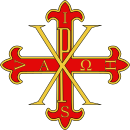 Cross of the order | |
| Founded | c. 330 (legendary) c. 1545 (actual) |
| Royal house | House of Bourbon-Two Sicilies House of Bourbon-Parma |
| Religious affiliation | Roman Catholic |
| Ribbon | Light blue |
| Motto | In hoc signo vinces |
| Founder | Constantine the Great (legendary) Andrea Angelo Flavio Comneno (actual) |
| Grand Master | Disputed: Prince Pedro, Duke of Calabria Prince Carlo, Duke of Castro Prince Carlos, Duke of Parma |
| Grades | House of Bourbon-Two Sicilies: See all House of Bourbon-Parma: Sovereign Knight Grand Cross with Collar Knight Grand Cross Knight Commander Knight/Dame |
| Precedence | |
| Next (higher) | House of Bourbon-Two Sicilies: Royal Order of Saint Januarius House of Bourbon-Parma: None (highest) |
| Next (lower) | House of Bourbon-Two Sicilies: Royal Order of Saint Ferdinand and of Merit House of Bourbon-Parma: Ducal Royal Order of Saint Louis |
Sash & ribbon of the order | |
Though the order is alleged to have been founded in its original form by Constantine the Great in Antiquity and then restored under later Byzantine emperors, the actual origin of the order can be traced to the 16th century, when it was founded by an Albanian family by the name Angelo Flavio Comneno. Though this family, extinct in 1698, claimed to be connected to the Byzantine Komnenos and Angelos dynasties, such a familial connection cannot be proven. The order being connected to the Byzantine Empire is fantasy as chivalric orders were completely unknown in the Byzantine world and as such, much of the alleged history of the order was invented much later. Outside the generally recognized line of grand masters from its origin in the 16th century to the present day, there have been many people claiming to be grand masters who have been forgers and title-seekers hoping to gain support for invented lines of descent from ancient and medieval nobility.
History
Origins
The legendary origins of the Sacred Military Constantinian Order of Saint George trace its foundation to an apocryphal order founded by Constantine the Great.[7] Although it has sometimes been held that the order would have been restored/created by the Byzantine emperor Isaac II Angelos, any claimed connection between chivalric orders and the Byzantine Empire are pure fantasy as chivalric orders were completely unknown in the Byzantine world.[8]
The order was actually founded by Albanian nobles of the Angelo Flavio Comneno family (claiming connection to the Byzantine houses of Angelos and Komnenos) in the 16th century, attested in association with a man by the name Andrea Angelo Flavio Comneno, and his brother Paolo Angelo Flavio Comneno, in 1545. In 1545, the brothers Andrea and Paolo were officially acknowledged as descendants of the Angeloi emperors (a claim seen as doubtful today) by Pope Paul III. The brothers were also guaranteed the right to inherit territory in the former Byzantine Empire, should such territory be recovered from the Ottomans.[9] Their family remained grand masters of the order until 1698 when Giovanni Andrea Angelo Flavio Comneno Lascaris Paleologo, who also claimed the titles of "Prince of Macedonia", "Duke of Thessaly" and "Count of Drivasto, Durazzo etc." upon his death assigned the order not to any living relatives but to Francesco Farnese, the duke of Parma.[10]
Outside the generally recognized line of grand masters from its origin in the 17th century to the present day, there have been many people claiming to be grand masters who have been forgers and title-seekers hoping to gain support for invented lines of descent from ancient and medieval nobility.[1]
Farnese family, male primogeniture
Its incorporation as a religious order of the Catholic Church hereditary in the House of Farnese and its heirs, the Bourbons, dates from the transfer to Francesco Farnese on 11 January 1698, an act confirmed in an imperial diploma, "Agnoscimus et notum facimus", of the emperor, Leopold I, dated 5 August 1699, and the apostolic brief, "Sincerae Fidei", issued by Pope Innocent XII on 24 October 1699.
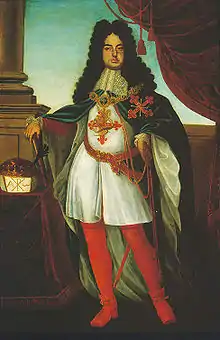
These confirmed the succession of the grand magistry to the Farnese family and its heirs as an ecclesiastical office and, crucially, did not tie it to tenure of sovereignty of the Duchy of Parma. Among the first major acts of the Farnese grand magistry were revised, amended and expanded statutes, issued on 25 May 1705 and confirmed in a papal brief dated 12 July 1706; both these confirmed the requirement that the grand magistry should pass by male primogeniture. Following the order's contribution to Prince Eugene of Savoy's campaign to drive the Turks from the Balkans between 1716 and 1718, Pope Clement XI, a former cardinal protector of the order, confirmed the order as a religious order of the Roman Catholic Church in the bull, "Militantis Ecclesiae", of 27 May 1718.
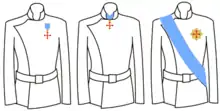
Claim by the House of Two Sicilies
With the death of the last male of the House of Farnese on 30 January 1731, the grand magistry was claimed by Charles, eldest son of Elisabeth Farnese and King Philip V of Spain; Charles also inherited the duchies of Parma and Piacenza from the Farnese. After becoming king of Naples and Sicily in 1734, Charles was forced to surrender Parma to Austria in 1736, but he retained the Constantinian grand magistry. On 16 October 1759, Charles abdicated the grand magistry to his second surviving son, King Ferdinand IV and III of Naples and Sicily (from 1815 Ferdinand I of the Two Sicilies). The administration of the order was transferred from Parma to Naples in 1768.
Despite the loss of its original basis of papal legitimacy, the Order continued to function under Ferdinand I and his successor heads of the House of Bourbon-Two Sicilies. It has continued to do so after the fall of the Kingdom of Two Sicilies; the view of the Bourbon-Sicily family is that the grand magistry was never united with the Sicilian crown, but remained independent. Ferdinand's words, in a decree of 8 March 1796, were: "In his (the king's) royal person there exists together two very distinct qualities, the one of monarch of the Two Sicilies, and the other of grand master of the illustrious, royal and military Constantinian Order, which though united gloriously in the same person form nonetheless at the same time two separate independent lordships".
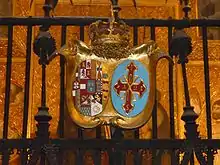
The succession of Ferdinand I as grand master was resented by some of the Parmesan nobility but when in 1748, Charles III's younger brother Philip succeeded as duke of Parma, he explicitly recognised his brother Charles and later his nephew Ferdinand as grand master in a series of decrees and official acts. Philip's son Ferdinand, after becoming duke of Parma, sent an emissary to the Spanish court to try and persuade the king of Spain to intervene with the king of Naples and Sicily and persuade the latter to give up the grand mastership, but without success.
Separate Parmesan Order from 1817
The Parmesan Constantinian Order was a new foundation, instituted by Marie Louise, Duchess of Parma, in 1817 and following her death the duke of Lucca, heir to the Bourbon-Parma succession, became duke of Parma under the terms of the Congress of Vienna and assumed the grand mastership which is today claimed by Prince Carlos, Duke of Parma. See the historical note authored by Paolo Conforte, a senior officer of the Parma dynastic order, who maintains that the Parma Order, despite its late foundation, is the successor of the original order; this view was explicitly rejected by the Holy See in 1860 and in 1913 the Holy See did not respond to a request from the Parma ducal family to accord their order similar privileges to those granted to the order of which Prince Alfonso, Count of Caserta was grand master.
The Order under the House of Two Sicilies
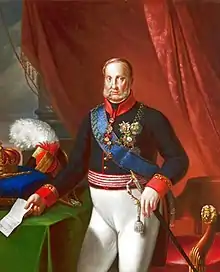
In 1910, Pope Pius X appointed the first of three successive cardinal protectors and, in 1913, approved a series of privileges for the chaplains of the order. In 1915, Pope Benedict XV dedicated the Constantinian chapel in the basilica of Santa Croce al Flaminio, which had been built with donations from the knights, who included Monsignor Eugenio Pacelli, later Pope Pius XII. In 1916, the pope restored the church of Saint Anthony Abbot to the Order - this church had originally been given to the Constantinian order along with the properties of the religious order of that name in 1777, but had been put under the direction of the archdiocese of Naples in 1861.
In 1919, new statutes received papal approval and Cardinal Ranuzzi de' Bianchi was appointed cardinal protector, the last to hold this post. Following the intervention of the grand magistry of the Order of Saints Maurice and Lazarus in 1924, whose grand master, the king of Italy, objected to the awarding of the order to leading Italian noblemen, the Holy See felt the close relationship with Prince Alfonso, Count of Caserta might prove an obstacle to settling the Roman question. It was, therefore, decided not to reappoint a successor to Cardinal Ranuzzi de' Bianchi at his death in 1927.
Disputed succession, further schism of the Order
The succession to the grand magistry of this order has been disputed among as many as three branches of Bourbons since 1960. The dispute is rooted in different interpretations of the so-called "Act of Cannes" of 14 December 1900 in which the count of Caserta's second son, Prince Carlo (grandfather of Infante Carlos, Duke of Calabria), promised that he would renounce his succession to the crown of the Two Sicilies in execution of the "Pragmatic Decree" of 1759. This decree required that if the king of Spain, or his immediate heir, should inherit the Two Sicilies crown, he would renounce the latter to the next in line. Whether the "Pragmatic Decree" applied to Prince Carlo's situation in 1900, and whether the grand magistry of the order was included in such a renunciation, are both issues in dispute.
Supporters of the late Infante Carlos, Duke of Calabria and his only son and heir, Prince Pedro, Duke of Calabria assert that Prince Carlo's renunciation was conditional on his actually inheriting both the Spanish and Two Sicilies crowns and/or that, even in that circumstances, such a renunciation did not include the position of grand master of the Constantinian order, which they regard as separate from the crown. A website of the so-called "Spanish" branch, headed by Prince Pedro, asserts that the renunciation was conditioned on facts that never arose, and that the order and the crown are governed by separate rules. Further, supporters of Infante Carlos argue that the "Act of Cannes" was legally defective and thus void. The Infante Don Carlos died on the 5 October 2015 and was succeeded by his only son, Prince Pedro, Duke of Calabria.

Supporters of Prince Carlo, Duke of Castro reject all three positions advanced by Infante Carlos' supporters, and claim that the rival claimant's ancestor validly renounced both the crown of the Two Sicilies and the grand magistry.[11]
Each branch appoints a Roman Catholic cardinal as grand prior. On 16 October 2012, the Vatican Secretary of State renewed its position that the Holy See does not recognise any order except the seven Papal Orders listed on their statement. The Sacred Military Constantinian Order of Saint George was not one of those orders.[12]
Version led by Prince Pedro, Duke of Calabria (Hispano-Neapolitan branch)
Spaniards and Italians who have been granted the Constantinian Order by Infante Carlos, Duke of Calabria and his heir Prince Pedro have applied for, and received, authorisation to wear the decorations of the order.[13]
In a decree of the Spanish Ministry of Foreign Affairs by the Introductor de Embajadores, 28 November 2014, the Ministry stated that along with the Sovereign Military Order of Malta, the Equestrian Order of the Holy Sepulchre and the Royal Order of Saint Januarius (of which Prince Pedro, Duke of Calabria, is also Grand Master) "... la Sagrada y Militar Orden Constantiniana de San Jorge fueron tuteladas por la Corona de Espana o se hallan estrechamente vinculadas a su Historia, tal y como preve en este sentido el Ministerio de Defensa en su Instruccion General 06/12 sobre autorización de uso de recompensas civiles y militares."[14] ("...the Sacred Military Constantinian Order of Saint George, came under the protection of or were linked to the Crown and history of Spain, as set forth by the Ministry of Defence in its General Instruction 06/12, on permission to wear civil and military awards"). The status of the Constantinian Order was again defined in a statement by the Introductor de Embajadores, dated 2 June 2017 and issued in Spanish, French and English - the latter read: "...Hereby Certifies That the Sacred Military Constantinian Order of Saint George and the Royal Order of Saint Januarius are officially recognized by Spain as Orders historically tied to the Crown of Spain, pursuant to the Ministry's Circular Order 4/2014 of 28 November. The use of the insignias of these two Orders is subject to the appropriate authorization, issued by the Ministry of Foreign Affairs, as stipulated by the Royal Decree of 5 June 1916, signed by the Introducer of Ambassadors, Ambassador-Secretary of the Order of Isabella the Catholic and the Order of Civil Merit." The Constantinian Order awarded by Prince Pedro is explicitly authorised to be worn by the governments of Italy and Mexico and citizens of the Netherlands have also been authorised to wear it. The United States Department of the Army has included the Order among those for which authorisation may be given to wear the decorations on the official list of such awards, under Spain.

Version led by Prince Carlo, Duke of Castro (Franco-Neapolitan branch)
In the 1990s, under the authority of Prince Carlo, Duke of Castro, the organization and activities of his version of the order were "revived" as the so-called "Delegation for Great Britain and Ireland of the Sacred Military Constantinian Order of Saint George". This version of the Order has appointed a British Catholic public relations advisor as its "magistral delegate", and has awarded him other honours.[15] The longstanding version of the Order has no connection with this PR advisor, nor with his business activities, nor with the order of which he is described as “delegate”.[16]
The Italian and Hungarian governments among others have authorised members of the Franco-Neapolitan branch, bestowed by Prince Carlo, Duke of Castro, to wear the insignia.[17]
In 2011, the version of the Constantinian Order headed by the Duke of Castro, became one of the 3,536[18] NGO's. In 2011-12 some 600 organizations applied for consultative status. On average between 100 and 150 applications are recommended by the Committee in each of its two sessions per year non-governmental organizations to hold consultative status at the Economic and Social Council at the United Nations.[19] The United Nations recognises the organisation as qualifying for this status without acknowledging its historical claims or any particular character as an Order of knighthood.
In 2016, the branch of the Order led by the Duke of Castro was involved in controversy over the election of Patricia Scotland as Commonwealth Secretary-General.[20] It was alleged that Scotland used the Order's awards to influence votes in her favour through reciprocal exchanges of honours.[21] Investigations resulted in a knighthood granted to the Duke of Castro by the Governor General of Antigua being revoked.[22]
Attempted reconciliation
On 24 January 2014, the day before the Blessed Beatification of the Venerable Servant of God Princess Maria Cristina of Savoy (later Queen Maria Cristina, Queen Consort of the Two Sicilies, the two disputed heads of the house: Prince Carlo, Duke of Castro and Prince Pedro, Duke of Noto (on behalf of his father Prince Carlos, Duke of Calabria) signed an "Act of Reconciliation" at Naples' Excelsior Hotel.
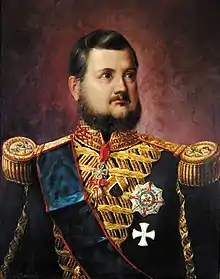
This act appeared to have ended the longstanding differences over the titles used by the two branches of the House of the Two Sicilies. The signing of the act of reconciliation was done in the presence of the Duchesses of Noto and Castro, the Duke of Noto's mother, the Duchess of Calabria, the Duke of Noto's sisters, Maria and Inés, and their husbands, Archduke Simeon and Michele Carrelli Palombi, their aunt, Princess Teresa, Marquesa de Laserma, the Duke of Castro's sister, Princess Napoleon, Prince Casimiro of Bourbon-Two Sicilies and his wife Princess Margherita, and the Duke of Braganza. Owing to his state of health, the Infante Don Carlos, Duke of Calabria was unable to attend the ceremony.
The Act stated that the two branches will recognize each other's titles for the present holders and their successors; the titles of the senior, Spanish line, being Duke of Calabria, Duke of Noto and Duke of Capua, and of the junior line, being Duke of Castro and Duchess of Palerma and Duchess of Capri which were accorded to the Duke and Duchess of Castro's two daughters. The final intention was to work together to unite the Constantinian Order as well as perhaps share the grand mastership of the Two Sicilies Order of St. Januarius (the revival of the Order of Francis I has never been accepted by the senior, Spanish line.)[23]
Renewed schism
In May 2016 Prince Carlo unilaterally renounced the agreement and subsequently conferred the titles of Duchess of Calabria and Duchess of Noto on his daughters, declaring the former to be the heiress to the headship of the Royal House and the Constantinian Grand Mastership. This act has not been recognised by members of the branch descended from Prince Gabriel of Bourbon-Two Sicilies. The legality of this has been disputed by Prince Pedro on the grounds that the succession to the Two Sicilies crown was established in two international treaties (Vienna 1737 and Naples 1759) as well as the Pragmatic Decree of 1759 and the nineteenth century Two Sicilies constitutions and therefore could not be changed by a unilateral act, even by an undisputed head of the royal house. The succession to the Constantinian Grand Mastership was confirmed by an Imperial Bull and a Papal Brief, and by the Bull Militantis Ecclesiae, and required that the Grand Mastership, an ecclesiastical office in canon law, could only be held by males and must pass by primogeniture to the heirs of the House of Farnese; the purported change to the succession by Prince Carlo has not been approved by the Holy See.
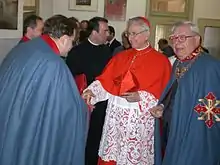
Ranks of the Order
Grades
- Special Class
(This category invented by the Order headed by the Duke of Castro and are not considered part of the historical ranks of the Order.)
- Sovereign Knight Grand Cross with Collar
- Knight Grand Cross, Special Class
- Justice
- Bailiff Knight Grand Cross with Collar of Justice
- Bailiff Knight Grand Cross of Justice
- Knight/Dame Grand Cross of Justice
- Knight/Dame Grand Officer of Justice (The rank of Commander was invented by the Order headed by the Duke of Castro; it is a characteristic of a merit award and not a confraternal Order)
- Knight/Dame Commander of Justice (The rank of Commander was invented by the Order headed by the Duke of Castro; it is a characteristic of a merit award and not a confraternal Order)
- Knight/Dame of Justice

- Grace or Jure Sanguinis
(The name Grace was changed to Jure Sanguinis by Infante Alfonso, Duke of Calabria, when Grand Master.)
- Knight/Dame Grand Cross of Grace, or Jure Sanguinis
- Knight/Dame Grand Commander of Grace (The rank of Commander was invented by the Order headed by the Duke of Castro)
- Knight/Dame Grand Officer of Grace, Special Class (a rank invented by the Order headed by the Duke of Castro)
- Knight/Dame Grand Officer of Grace (a rank invented by the Order headed by the Duke of Castro)
- Knight/Dame of Grace or Jure Sanguinis
- Merit
- Knight/Dame Grand Cross of Merit
- Knight/Dame Grand Commander of Merit, Special Class (a rank invented by the Order headed by the Duke of Castro)
- Knight/Dame Grand Commander of Merit (a rank invented by the Order headed by the Duke of Castro)
- Knight/Dame Grand Officer of Merit, Special Class (a rank invented by the Order headed by the Duke of Castro)
- Knight/Dame Grand Officer of Merit (a rank invented by the Order headed by the Duke of Castro)
- Knight/Dame Commander (a rank invented by the Order headed by the Duke of Castro)
- Knight/Dame of Merit
- Office
- Knight/Dame of Office
- Medal
- Gold, silver or bronze
- Special Class (a rank invented by the Order headed by the Duke of Castro)
- 1st Class
- 2nd Class (a rank invented by the Order headed by the Duke of Castro)
| Insignia | ||||||
 |
 |
 | ||||
| Collar | Knight sash | Dame ribbon | ||||
| Ribbon bars | ||||
See also
- Royal Order of Francis I
- Order of Saint Ferdinand and of Merit
- Order of Saint George and Reunion
- Order of Saint Januarius
The Constantinian Order of Saint George published by the Boletín Oficial del Estado, Madrid, 2018
References
- Nicol, Donald M. (2002-05-09). The Immortal Emperor: The Life and Legend of Constantine Palaiologos, Last Emperor of the Romans. Cambridge University Press. p. 120. ISBN 978-0-521-89409-8.
- The Institution, Laws and Ceremonies of the Most Noble Order of the Garter Collected and Digested Into One Body Etc. J. Macock. 1672. p. 63.
- https://www.indcatholicnews.com/news/21247
- Sainty, Guy Stair (2018-12-01). The Constantinian Order of Saint George: and the Angeli, Farnese and Bourbon families which governed it. Boletín Oficial del Estado. p. 12. ISBN 978-84-340-2506-6.
- "Note of Clarification from the Secretariat of State" (Press release). Pontifical Council for Social Communication. 16 October 2012. Retrieved 27 November 2012.
- Adernò, Fabio (22 October 2012). "La Santa Sede e gli Ordini Cavallereschi: doverosi chiarimenti (Seconda parte)". Zenit (in Italian). Retrieved 22 August 2016.
- "Sacred Military Constantinian Order Of Saint George". Constantinianorder.org. Retrieved 13 November 2016.
- Nicol, Donald M. (2002-05-09). The Immortal Emperor: The Life and Legend of Constantine Palaiologos, Last Emperor of the Romans. Cambridge University Press. p. 121. ISBN 978-0-521-89409-8.
- Sainty, Guy Stair (2018-12-01). The Constantinian Order of Saint George: and the Angeli, Farnese and Bourbon families which governed it. Boletín Oficial del Estado. p. 58. ISBN 978-84-340-2506-6.
- Nicol, Donald M. (2002-05-09). The Immortal Emperor: The Life and Legend of Constantine Palaiologos, Last Emperor of the Romans. Cambridge University Press. p. 119. ISBN 978-0-521-89409-8.
- History asserting that the "Act of Cannes" was a fully valid act of renunciation, Realcasadiborbone.it; accessed 13 November 2016.
- "Note of Clarification from the Secretariat of State". news.va. Pontifical Council for Social Communication. 16 October 2012. Retrieved 27 November 2012.
Vatican City (VIS) - In response to frequent requests for information concerning the recognition by the Holy See of Equestrian Orders dedicated to the saints or to holy places, the Secretariat of State considers it opportune to reiterate what has already been published, namely that, other than its own Equestrian Orders (the Supreme Order of Christ, the Order of the Golden Spur, the Pian Order, the Order of Saint Gregory the Great, and the Order of Pope Saint Sylvester), the Holy See recognises and supports only the Sovereign Military Order of Malta - also known as the Sovereign Military Hospitaller Order of Saint John of Jerusalem of Rhodes and of Malta - and the Equestrian Order of the Holy Sepulchre of Jerusalem. The Holy See foresees no additions or innovations in this regard. All other orders, whether of recent origin or mediaeval foundation, are not recognised by the Holy See. Furthermore, the Holy See does not guarantee their historical or juridical legitimacy, their ends or organisational structures. To avoid any possible doubts, even owing to illicit issuing of documents or the inappropriate use of sacred places, and to prevent the continuation of abuses which may result in harm to people of good faith, the Holy See confirms that it attributes absolutely no value whatsoever to certificates of membership or insignia issued by these groups, and it considers inappropriate the use of churches or chapels for their so-called "ceremonies of investiture".
- Gregor Gatscher-Riedl, In hoc signo vinces. Zwischen religiösem Mythos und politischem Anspruch von Byzanz nach Neapel. Die Geschichte des Heiligen Konstantinischen Ritterordens vom Heiligen Georg, Vienna 2012, p. 173 (in German)
- Orden Circular 4/2014 Instrucciones sobre el uso de condecoraciones extranjeras por ciudadanos espanoles. 28 de noviembre de 2014.
- Website of Constantinian Order, accessed 20 June 2016
- Guy Stair Sainty, vice-grand chancellor of the Order. As reported in http://antiguaobserver.com/catholic-order-disowns-honours-awards-to-caribbean-leaders/ Antigua Observer. August 24, 2016. "The Order purportedly revived in the UK by Bailey is described on its website as the “Delegation for Great Britain and Ireland”; however, in a follow up email, Guy Stair Sainty, vice-grand chancellor of the Order, said it has no connection with Bailey, his business activities or the order of which he is described as “delegate”. Sainty explained that the Constantinian Order concentrates primarily on its Catholic mission and never “exchanges” its membership with anyone for any reason, since this would be contrary to the statutes and character of the Order as a Catholic, chivalric, confraternal institution. “Neither are we interested in expensive entertainments nor in constant publicity, which is why we have not issued any public statement until now, when the good name of our Order has repeatedly been the subject of so much critical commentary,” he added. Sainty went on to note that the grant of awards for “’interfaith’ services or whatever” to the likes of President Assad of Syria and former President Saleh of Yemen and various state officials in other countries, including the Caribbean, has no worth. “The self-evident conflict of interest between Mr Bailey’s role as a businessman apparently acting on behalf of states for fees, yet exchanging decorations of this controversial Constantinian Order … and then claiming awards in return would appear to be entirely contrary to the spirit of this ancient Catholic institution,” he said."
- Gregor Gatscher-Riedl, In hoc signo vinces. Zwischen religiösem Mythos und politischem Anspruch von Byzanz nach Neapel. Die Geschichte des Heiligen Konstantinischen Ritterordens vom Heiligen Georg, Vienna 2012, p. 172
- "Basic Facts about ECOSOC Status". United Nations, Department of Economic and Social Affairs, NGO Branch. csonet.org. Retrieved 13 November 2016.
Currently 3,536 NGOs enjoy consultative status with ECOSOC ... as of November 2011....•
- List of non-governmental organizations in consultative status with the Economic and Social Council as of 1 September 2011 (PDF) (E/2011/INF/4 ed.). New York: United Nations, Economic and Social Council. 15 November 2011. p. 65. Retrieved 27 November 2012.
Sacro Militare Ordine Costantiniano di San Giorgio (2011)
- enquiries@thetablet.co.uk, The Tablet-w. "Order denies allegations it awarded knighthoods for political influence". The Tablet. Retrieved 2020-03-06.
- "Corruption a none issue for the Caribbean, just go to Mama Mia!". Dominica Patriot. 2020-02-20. Retrieved 2020-03-06.
- https://www.thegazette.co.uk/notice/2836491
- Koenig, Marlene Eislers. "RECONCILIATION IN THE HOUSE OF BOURBON-TWO SICILIES". Royalmusingblogspotcom.blogspot.com. Retrieved 27 January 2014.
External links
| Wikimedia Commons has media related to Sacred Military Constantinian Order of Saint George. |
- Hispano-Neapolitan branch website (Grand Master: Prince Pedro, Duke of Calabria)
- Franco-Neapolitan branch website (Grand Master: Prince Carlo, Duke of Castro)
- Sacred Angelic Imperial Constantinian Order of Saint George (Grand Master: Prince Carlos, Duke of Parma)
- Bourbon-Parma branch's history of the order (PDF file in Italian)
